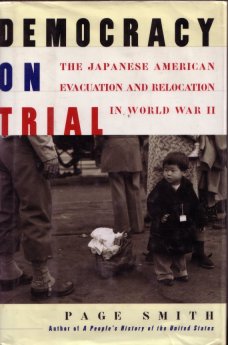
Democracy on Trial: The Japanese American Evacuation and Relocation in World War II

By Page Smith, 1995
The author starts by talking about World War II just before the U.S. entered it, along with how Japanese aggression alarmed the people on the West Coast and contributed to the anti-Japanese fervor, and then goes on to discuss Executive Order 9066.
The author then takes a step back in history and talks about the opening of Japan by Admiral Perry along with other things going on in Japan at the time. The next chapter talks about the growing imperial might of Japan and how that related to the building of the Panama Canal.
The author then talks about the Japanese Americans on the West Coast, what they did for a living, giving numerous specific examples of immigrants. He then talks about the Issei/Nisei differences and also talks about the Kibei, those who were born in the U.S., educated in Japan and returned to the U.S.
Also covered is the specific differences in how Japanese aggression was being viewed by the various generations of immigrants.
Next is how the Japanese Americans reacted to the bombing of Pearl Harbor with very specific examples. Included in this section is the beginning of the government program that eventually led to the internment of the Issei and Nisei, and the role of the JACL.
The author does a really good job of discussing the mood of the times, how people were reacting to the Japanese military successes, again with numerous specific examples. DeWitt's attitudes and plans are covered in the same chapter.
Terminal Island is discussed in the next chapter. This was an island of Japanese American fishermen who were immediate targets of the FBI and the military, who made the assumption that, since they were fishermen and had boats, they were using the boats to communicate with Japanese forces in the area. What happened to people being evacuated is covered along with its effects on the concept of voluntary evacuation.
The next chapters discuss the voluntary evacuation, the involuntary evacuation, and in particular the farms and other personal property that were lost to the Issei and Nisei in the process of internment. Material on the War Relocation Authority comes next in the book.
Then there's a long an excellent chapter on the assembly centers. Efforts to get students into other schools follows, and then the entire next section is on life in the internment camps. Again, a lot of details are included. Then the author turns his attention towards the troubles that did occur at the camps, especially the Manzanar riot where two evacuees were killed by the soldiers. Resettlement is the next to be discussed, and then the entire issue of the loyalty questionnaire and the military wanting Nisei soldiers.
After that is a chapter dealing with Tule Lake as the isolation/detainment center for the "no-no's" and certain others. The author also includes material on the social and cultural life of the centers, something that helped the internees manage to survive what they were going through. The closing of the centers and all that entailed is next to be covered in the book.
The final chapter is "loose ends" and has some very interesting material, including how nine of their advanced submarines were cruising off the West Coast and had planned to bombard San Francisco on Christmas Eve, but the plan was called off because of potential harm to the Japanese Americans.
The author also states his position about the potential military threat of the Japanese Americans. "Those who condemn the relocation as a ‘racist decision' have to climb over a mountain of evidence that many Japanese living in California were ardent Japanese nationalists." He adds that DeWitt realized he could not protect the Japanese Americans against the "mounting public hostility against them."
Included in this discussion is the matter of the Kibei and the parents who sent them to study in Japan. The author believes that if an invasion of the West Coast had taken place, many of the Issei and Nisei would have fought for the U.S., some would have taken neither side, and some would have actively added the invading Japanese forces. "What I think we must admit is that responsible public officials, most of whom were publicly and privately extremely reluctant to take such a step, were persuaded by those ‘on the ground' and in command of the broadest range of evidence that the evacuation of the exclusionary zone was, if not essential, given the evidence, wise and prudent."
So the author does not make reference to the Majic documents, but does believe that there was a military necessity for the evacuation, if for nothing else than being on the safe side of things.
A very interesting book, indeed.
Main Index
Japan main page
Japanese-American Internment Camps index page
Japan and World War II index page
|